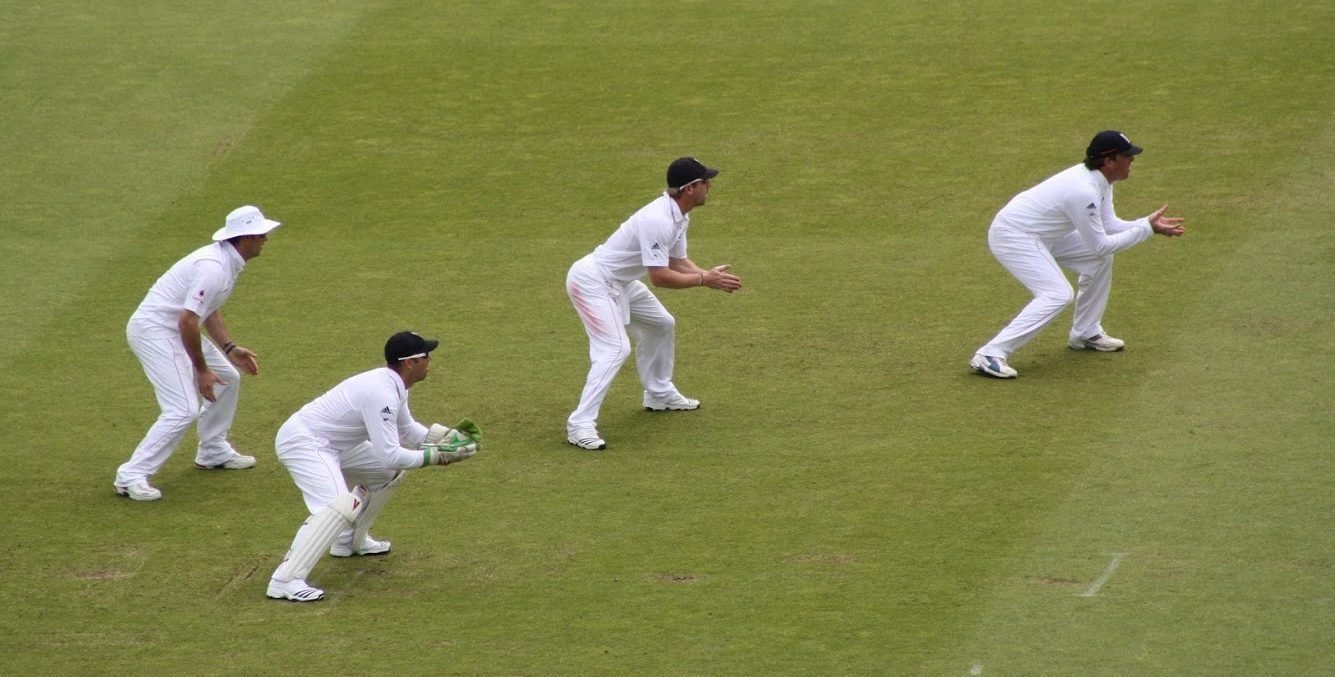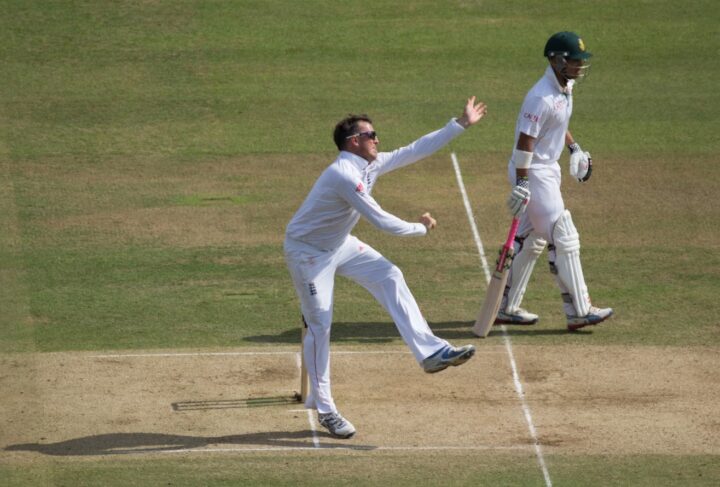Today Mark Cohen discusses England’s habit of dropping crucial slip catches. He argues that consistency of personnel is the solution to our cordon woes …
The cancellation of the fifth and final test at Old Trafford has robbed England of the opportunity to right a number of wrongs from a second Monday defeat of the summer.
Captain Joe Root has often resembled Atlas in shouldering the middle order for much of this summer. England’s failures with the bat may continue to bear the brunt of criticism but it is behind the bat in the slip cordon where an inquisitorial light should also be shone.
Six catches were grassed at the Oval alone – four in the first innings and two in the second – with CricViz noting that England last hit that total two years previously at the same ground. Rory Burns was the unfortunate scapegoat this time around, dropping Rohit Sharma twice on his way to a first test century away from India.
Consistency plays a huge role in slip fielding, with the great test match sides rarely changing the personnel of their cordons. Australia had Shane Warne as a near ever-present first slip throughout the 90s and 2000s, with Ricky Ponting at second and Justin Langer at third. Similarly England’s World Number One side of the early 2010s had Andrew Strauss, Graeme Swann and Alastair Cook.
Consistency in personnel also radiates certainty in positioning. The likes of Swann have spoken about knowing the dominant hand of those standing either side of them, which in turn helped them decide which edges to follow and those to leave alone.
England have chopped and changed their slip cordon in the last few years with such regularity that consistency is nowhere to be found. During the last India tour of England in 2018, Alastair Cook, Keaton Jennings and Jos Buttler occupied the cordon. Fast forward to the Oval last week and none of these three, for a variety of reasons, were anywhere near an England shirt let alone the slip cordon.
Buttler’s absence would have only been for a single game, had the Old Trafford test gone ahead. When he makes an expected return in Australia this winter, it will be with the wicketkeeper’s gloves. If the incumbent at the Oval, Jonny Bairstow, retains his place then he would most likely return to second slip, replacing Burns. This is of course all speculative, but it demonstrates how that need for consistency in the slips has continued to evade England over recent years.
Slip fielding has been described by players and coaches as an ‘art’. Like many aspects of the game, it has developed over time, with individuals honing their own style and preference in order to succeed at the position. The most successful slip fielders often speak about the need to find a naturally comfortable position and technique.
Ian Botham has talked about resting his hands on his knees and watching the ball out of the bowler’s hand and onto the bat. Botham said this allowed him to relax and to a degree anticipate the direction of the ball, helping him on his way to over 100 slips catches for England.
A more recent exponent of watching the ball from the bowler’s hand was Paul Collingwood, who narrowly missed out on joining Botham in the ‘100’ club. He used a similar ball-watching technique to great effect at a variety of positions, from the slips, through to gully and squarer still at point.
Another renowned slip fielder, Mark Waugh, preferred to let his arms hang down rather than place them on his knees. This technique certainly did not hinder him on his way to 181 catches, most of them in the slips.
His Australian colleague, Ponting, was the only man to better Waugh’s record. The former spoke about preferring to watch the bat rather than the ball during a memorable TV demonstration on the Trent Bridge outfield during the 2015 Ashes Test. Ponting was flanked in an inter-Ashes slip cordon by Michael Atherton and Nasser Hussain.
Unlike Ponting, Atherton spoke of watching the ball from his position at first slip. His and Ponting’s styles both differed but they both looked unmistakeably relaxed whilst repeatedly pouching catches under the watch of the Sky Sports cameras. Hussain, by contrast, looked tense and fidgety. The ‘poppadum fingers’ that ruled him out of numerous test matches during his career may have been as much down to a poor technique as brittle hands. Hussain put two catches down whilst Atherton and Ponting comfortably caught all of theirs. It was a small sample size but demonstrated the natural art of slip catching against those that maybe think a bit too much.
It is anyone’s guess as to what the present day England slip cordon will look like in Australia and beyond, but there can be no doubting the importance of catches behind the wicket when playing the old enemy on their own patch. One only has to look at the 98 all out at Melbourne in 2010, with all ten Australian wickets being caught by the keeper, in the slips or at gully.
Consistently putting your natural slip catchers in the same positions will always be the key to success. The performance of Burns and his fellow slip fielders are the most recent reminder that this success will never be achieved behind a rotating door of team selection. More slip-ups will follow in Australia unless this is brought to a halt.
Mark Cohen









No doubt a great deal of thought has gone into this behind the scenes at Camp England. The pity is our opponents have left town to take part in the IPL…
“Peter Drake”
“teacher” and cricket nut
Hexham
The fielding coach doesn’t seem to get much blame – that would be fair enough if England didn’t have a tendency to get articles in the media praising management when things go right.
Botham’s hands-on-knees’ technique had something to do with lower back trouble as well. Hussain was somewhat unusual in that he specialised as a slip fielder to spinners.
It was rank bad captaincy to persist with Burns at slip when he doesn’t even position himself there for Surrey and is clearly not a natural slip fielder. It’s not as if he is a bad fielder – far from it – and there were often other close fielding positions to which he would have been better suited.
With precious little opportunity to practice this art in white ball and the increasing amount our central contracted cricketers are denied county cricket what do you expect. It’s not just about having a good pair of hands it’s about maintaining concentration over long periods of inactivity. No one specialises in fielding poisitons anymore, you have to be versatile in the modern game. The classic example this summer is what do you do with Bairstow if he’s not keeping. He obviously has good hands and more practice at concentrating for long periods behind the stumps than most, but he does see more of the ball there as wicketkeeper, so there’s less inactivity. Yet he’s a brilliantly athletic outfielder. So what happens, he gets shifted around doing a bit of everything and shells a couple in the slips.
Whilst the structure of the game moves in it’s present direction there’s no solution in the offing.
For all his faults, Keaton Jennings was a fantastic fielder and catcher, I don’t remember him ever dropping one. Despite batting & bowling records improving thansk to higher fitness levels, catching doesn’t seem to have become better for most teams, which isn’t thecase for ground fielding.
How do they actually practice slip fielding? I only ever see them in the outfield before a game “messing about” with a coach feeding them deliberate edges. Fair enough, I am not a coach and I am sure they have more scientific methods in the lead up, it is probably a good way to “sharpen them up” prior to play starting. But what is not good is the laughing and joking when one is missed/dropped – similar to nets if practice is not done with a purpose bad habits can creep in.
It always worries me seeing the slip fielding practice going on just before start of play. Seems to me it’s broken or dislocated fingers waiting to happen. Last minute practice at anything rarely helps much, effective preparation is done well beforehand. On the day it’s a matter of settling the nerves as much as anything. For all that practice rigmarole the bowlers go through prior to taking the field they still seem to need a few balls to loosen up and the batsmen a few balls to get the feet moving.
The best advice I ever came accross for fielding generally was to soak your hands in warm water before you went out. This helps your fingers lose their initial stiffness. This applies in any weather as it’s the nerves that generally stiffen them at the start. Also before you put your boots on to go out to bat scrunch up your toes like folk advise you to do on a long plane flight. This helps circulation so your feet feel more comfortable generally when you put your boots on. As to wicketkeeping there’s all sorts of individual regimes that seem to go on, too numerous to mention here.